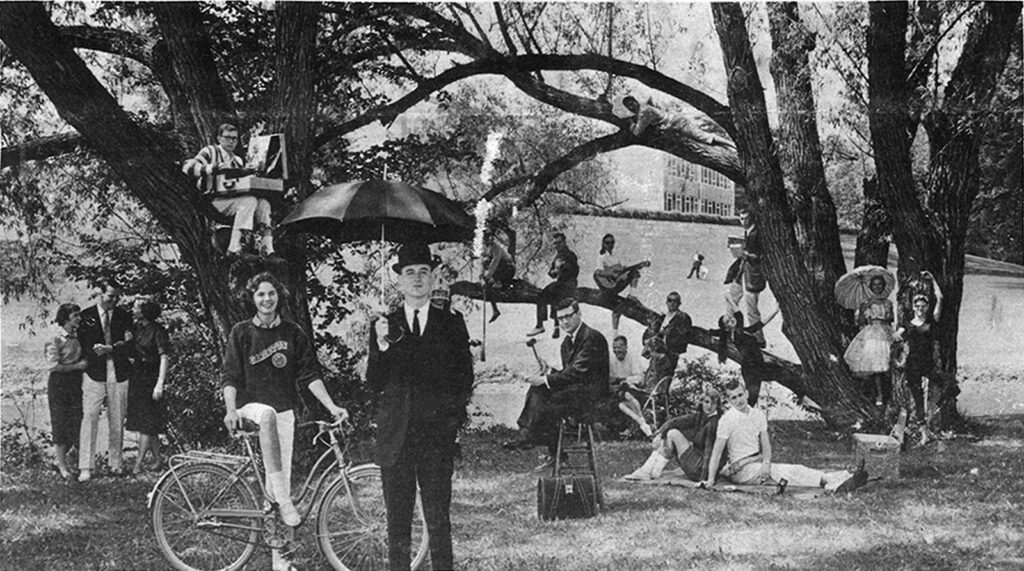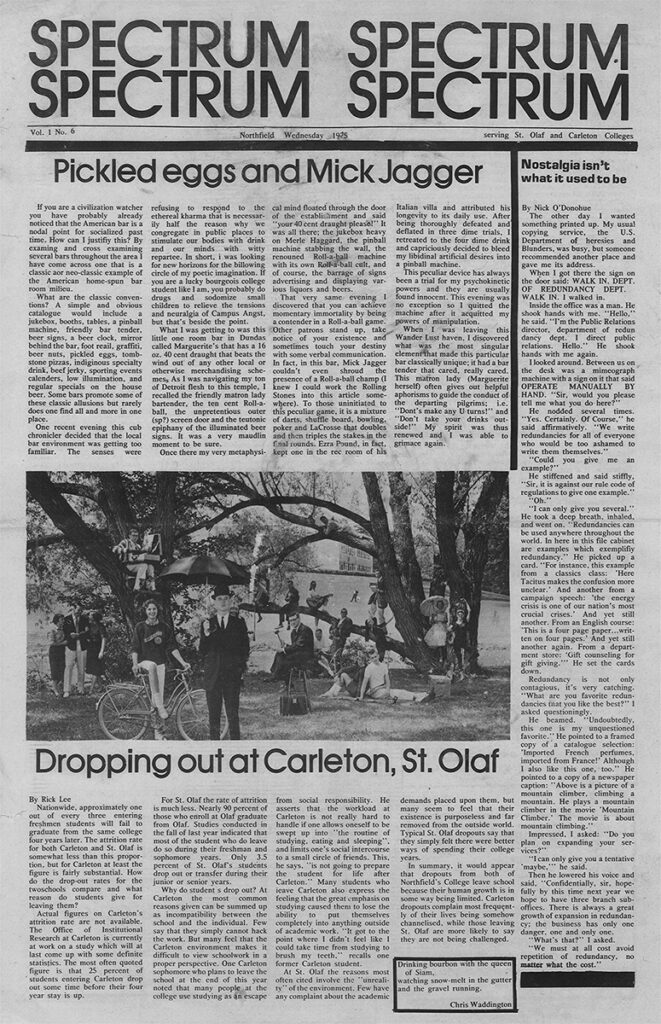Spectrum Editorials | Spectrum Literary Feats
Below are articles from the Spectrum frontpage edition. The top line below the header says “Vol. 1 No. 6” with “Northfield Wednesday 1975” and “serving St. Olaf and Carleton Colleges” I guess we get to pick the Wednesday?
Probably best article in this Alt News rag is the “Nostalgia isn’t what it used to be” …very heavy Monty Python humor, well executed.
I thought my own article was the worst one until I read a couple of others. They collectively make this more of a literary endeavor with just a smidgen of news.
by Tim Corwin
If you are civilization watcher, you probably already noticed that the American bar is a nodal point for socialized pastime. How can I justify this?
By examining several bars throughout the area, I have come across one that is a classic or neo-classic example of American home-spun bar milieu.
What are the classic conventions?
A simple and obvious catalog would include:
- A jukebox
- Booths
- Tables
- A pinball machine
- Friendly bar tender
- Beer signs
- A beer clock
- Mirror behind the bar
- Foot rail
- Graffiti
- Beer nuts
- Pickled eggs
- Tombstone pizzas
- Indigenous specialty drink
- Beef jerky
- Sporting events calendars
- Low illumination
- Regular specials on the house.
Some bars promote some of these classical allusions but rarely does one find all and more in one place.
One recent evening, this cub chronicler decided that the local bar environment was getting too familiar. The senses were refusing to respond to the ethereal kharma that is necessarily half the reason why we congregate in public places to stimulate our bodies with drink and our minds with witty repartee.
In short, I was looking for new horizons for the billowing circle of my poetic imagination. If you are a lucky bourgeois college student like I am, you probably do drugs and finger-twist your hair to relieve the tensions and neuralgia of Campus Angst, but that’s beside the point.
What I am getting to was this little one room bar in Dundas called Marguerite’s that has a 16 oz., 40 cent draught that beats the wind out of any other local or otherwise merchandising schemes.
As I navigate my ton of Detroit flesh to this temple, I recalled the friendly matron lady bartender, the 10 cent Roll-a-ball, the unpretentious out screen door and the teutonic epiphany of the illuminated beer signs. It was a very maudlin moment for sure.
Once there, my very metaphysical mind floated through the door of the establishment and said “your 40 cent draught please!”
It was all there: the jukebox heavy on Merle Haggard, the pinball machine stabbing the wall, the renowned Roll-a-ball game.
Other patrons stand up, take notice of your existence and sometimes touch your destiny with some verbal communication.
In fact, in this bar, Mick Jagger couldn’t even shroud the presence of a Roll-a-ball champ (I knew I could work the Rolling Stones into this article somewhere). To those uninitiated to this peculiar game, it’s a mixture of darts, shuffle board, bowling, poker and Lacrosse that doubles, then triples the stakes in the final rounds.
Ezra Pound, in fact, kept one in the rec room of his Italian villa and attributed his longevity to its daily use. After being thoroughly defeated and deflated in three dime trials, I retreated to the four dime drink and capriciously decided to bleed my libidinal artificial desires into a pinball machine.
This peculiar device has always been a trial for my psychokinetic powers and they are usually found innocent. This evening was no exception so I quit the machine after it acquitted my powers of manipulation.
When I was leaving this Wander Lust haven, I discovered what was the most singular element that made this particular bar classically unique: it had a bar tender who cared, really cared.
This matron lady (Marguerite herself) often gives out helpful aphorisms to guide the conduct of the departing pilgrims:
“Don’t take any U-turns!” and “Don’t take your drinks outside!”
My spirit was this renewed and I was able to grimace again.

By Rick Lee
Nationwide, approximately one out of every three entering freshman students will fail to graduate from the same college four years later. The attrition rate for both Carleton and St. Olaf is somewhat less than this proportion, but for Carleton at least the figure is fairly substantial. How do the dropout rates for the two schools compare and what reason do the students give for leaving them?
Actual figures on Carleton’s attrition rate are not available. The Office on Institutional Research at Carleton is currently at work on a study which will at last come up with some definite statistics. The most often quoted figure is that 25 percent of students entering Carleton drop out some time before their four-year stay is up.
For St. Olaf, the rate of attrition is much less. Nearly 90 percent of those who enroll at Olaf graduate from Olaf. Studies conducted in the fall of last year indicated that most of the students who leave do so during their freshman and sophomore years. Only 3.5 percent of St. Olaf’s students drop out or transfer during their junior or senior years.
Why do student’s drop out?
At Carleton, the most common reasons given can be summed up as incompatibility between the school and the individual. Few say that they simply cannot hack the work. But many feel that the Carleton environment makes it difficult to view schoolwork in a proper perspective. One Carleton sophomore who plans to leave the school at the end of this year noted that many people at the college use studying as an escape from social responsibility. He asserts that the workload at Carleton is not really hard to handle if one allows oneself to be swept up into “the routine of studying, eating and sleeping” and limit one’s social intercourse to a small circle of friends.
This, he says, “is not going to prepare the student for life after Carleton.” Many students who leave Carleton also express the feeling that the great emphasis on studying caused them to lose the ability to put themselves completely into anything outside of academic work. “It got to the point where I didn’t feel like I could take time from studying to brush my teeth,” recalls one former Carleton student.
At St. Olaf, the reasons most often cited involve the “unreality” of the environment. Few have any complaint about the academic demands placed upon them, but many seem to feel that their existence is purposeless and far removed from the outside world. Typical St. Olaf dropouts say that they simply felt there were better ways of spending their college years.
In summary, it would appear that dropouts from both of Northfield’s colleges leave school because their human growth is in some way being limited. Carleton dropouts complain most frequently of their lives being somehow channelized, while those leaving St. Olaf are more likely to say they are not being challenged.
By Nick O-Donohue
The other day, I wanted something printed up. My usual copying service, the U.S. Department of Heresies and Blunders, was busy, but somehow recommended another place and gave me its address.
When I got in there, the sign on the door said: WALK IN, DEPT. OF REDUNDANCY DEPT. WALK IN. I walked in.
Inside the office as a man. He shook hands with me. “Hello,” he said, “I’m the Public Relations director, department of redundancy dept. I direct public relations. Hello.” He shook hands with me again.
I looked around. Between us on the desk was a mimeograph machine with a sign on it that said OPERATE MANUALLY BY HAND. “Sir, would you please tell me what you do here?”
He nodded several times. “Yes, Certainly. Of Course,” he said affirmatively. “We write redundancies for all of everyone who would be too ashamed to write them themselves.”
“Could you give me and example?”
He stiffended and said stiffly, “Sir, it is against our rule of code of regulations to give one example.”
“Oh.”
“I can only give you several” He took a deep breath, inhaled, and went on. “Redundancies can be used anywhere throughout the world. In here, in this file cabinet are examples which exemplify redundancy.” He picked up a card. “For instance, this example from a classics class: ‘Here Tacitus make the confusion more unclear.’ And another from a campaign speech: ‘the energy crisis is one of our nation’s most crucial crises.’ And yet still another. From an English course: ‘This is a four page paper…written on four pages.’ And yet still another again. From a department store: ‘Gift counseling for gift giving.’” He set the cards down.
Redundancy is not only contagious, it’s very catching. “What are your favorite redundancies that you like best?” I asked questioningly.
He beamed, “Undoubtedly, this one is my unquestioned favorite.” He pointed to a framed copy of a catalog selection: ‘Imported French perfumes, imported from France!’ Although I also like this one, too” He pointed to a framed copy of a newspaper caption: “Above is a picture of a mountain climber, climb ing a mountain. He plays a mountain climber in the movie ‘Mountain Climber.’ The movie is about mountain climbing.”
Impressed, I asked: “Do you plan on expanding your services?”
“I can only give you a tentative maybe,” he said.
Then he lowered his voice and said, “Confidentially, sir, hopefully by this time next year we hope to have three branch sub-offices. There is always a great growth of expansion in redundancy: the business has only one danger, one and only one.”
“What’s that?” I asked.
“We must at all cost avoid redundancy, no matter what the cost.”
Drinking bourbon with the queen of Siam.
Watching snow-melt in the gutter and the gravel running.
-Chris Waddington

